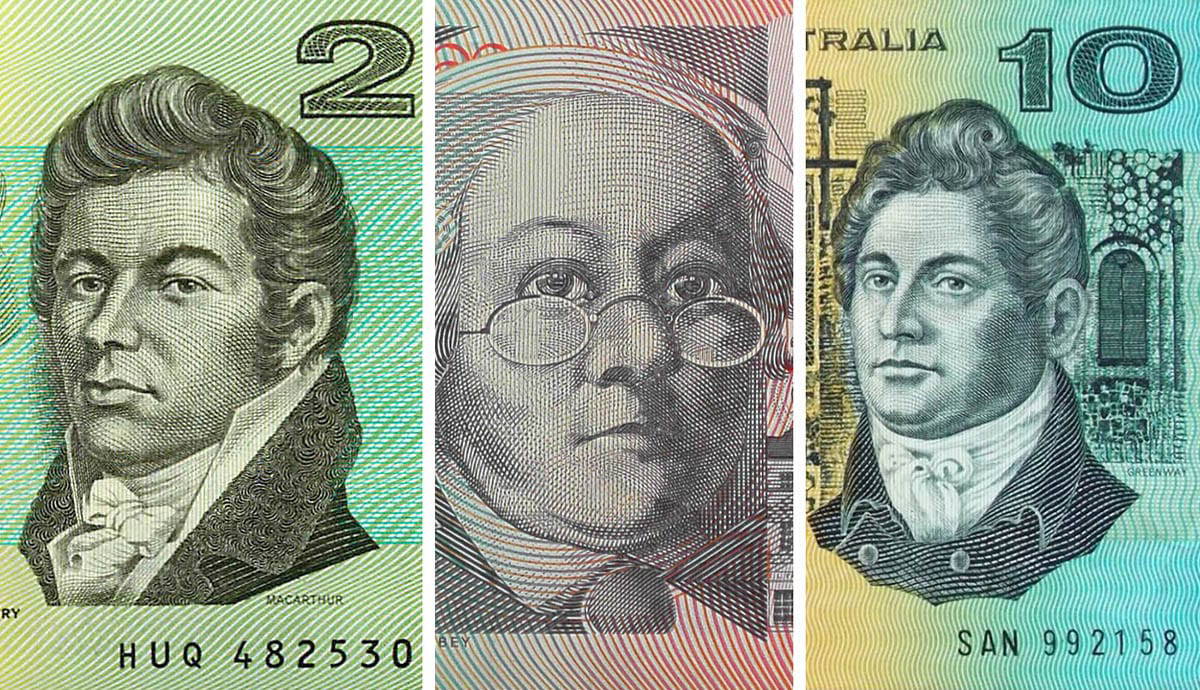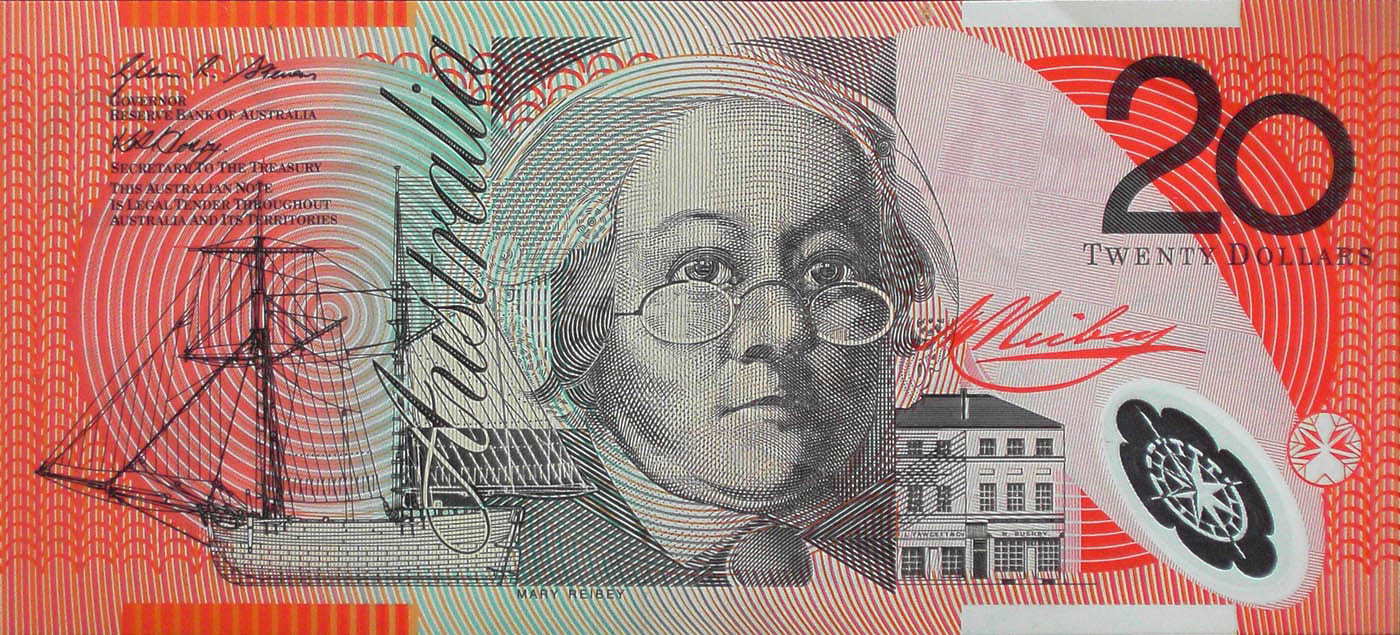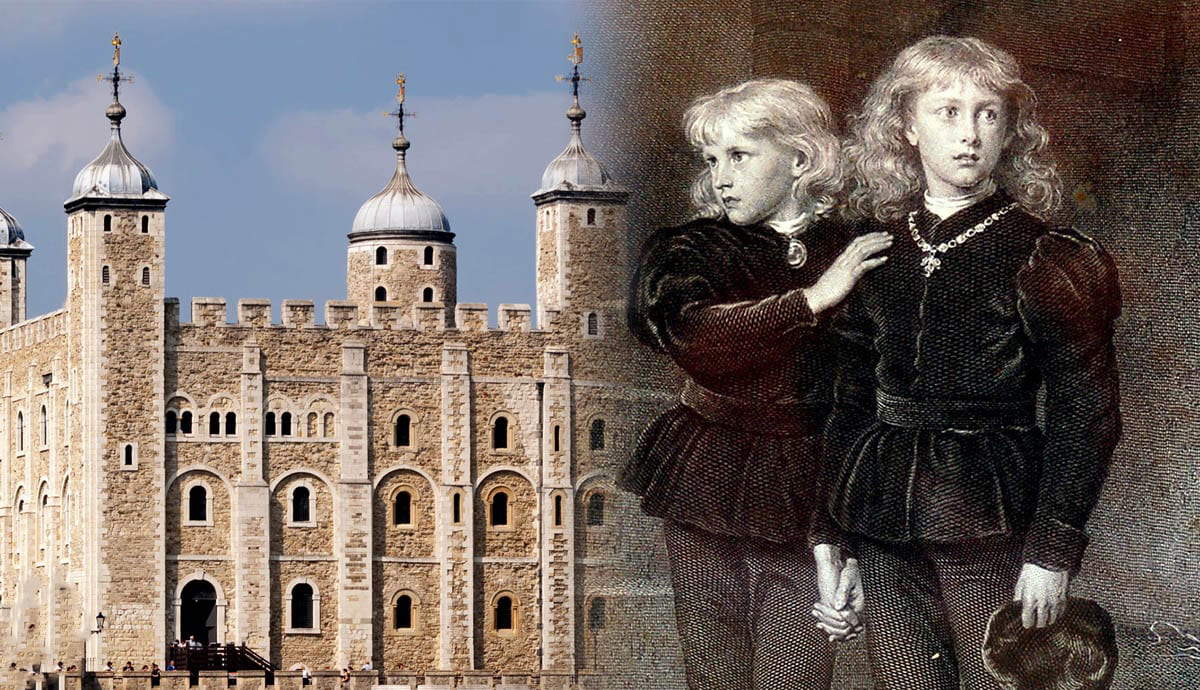
Where other nations glorify the great and the good on their cash, Australia is the only nation to ever feature a forger on its legal tender. The cash has also commemorated a teenaged horse thief, as well as a seditious social climber who was good with sheep and bringing down Governors.
These three people exemplify the Convict period of Australian History. Two by grabbing opportunities to better themselves and contribute to society in a great example of rehabilitation. The other to show how to take cynical advantage of privilege and social position. Two were convicted of relatively minor crimes, the other got away with mutiny and treason.
Let’s learn more about Francis Greenway, Mary Reibey, John Macarthur, and Australia’s currency!
Australia’s Currency: Convicts on Legal Tender

Australia’s currency (decimal) was introduced in 1966, it began changing to polymer notes with the first issued to commemorate the Bicentennial in 1988. Australians were featured for the first time on the new decimal currency of 1966. When Australia’s currency was redesigned for the polymer notes, a new set of Australians were commemorated.
Francis Greenway depicted on the former $10 note of Australia’s currency was convicted of forgery and became the Colonial Architect.
Mary Reibey who can be found on the current $20 note of Australia’s currency was transported to New South Wales after being found on a stolen horse while dressed as a boy. She was only 13 years old when convicted but by the time she was in her 20s, she was one of the wealthiest people in the country.
Mary Reibey and Francis Greenway’s lives demonstrate that given a second chance and opportunity, the convicts could prosper and build new respectable lives for themselves. The majority of convicts did just that and the Penal experiment of Australia is a great example of rehabilitation and what can be achieved given the chance.
Francis Greenway (1777-1837)

Francis Greenway was convicted of forging an architecture contract and was transported to New South Wales in 1814 with a 14-year sentence. On arrival, he wrote the most breathtakingly arrogant job application to Governor Lachlan Macquarie. But it worked, he was working for the Government and granted a ticket of leave within a year.
He had the luck to arrive under a Governor bent on improving the colony and who needed his skills. Together they built the town squares of the five ‘Macquarie Towns’ along the Hawkesbury River; Castlereagh, Pitt Town, Richmond, Wilberforce, and Windsor. In 1816, he was appointed the Civil Architect. During his term as Governor, Macquarie gave the colony 265 new buildings the vast majority designed by Francis Greenway.

Francis Greenway was a prolific architect, and many of his buildings are still landmarks in Sydney today. The former Government House Stables, now the Conservatorium of Music is probably the best known, it is certainly the most magnificent.
Mary Reibey (1777–1855)

Mary Haydock (later Mary Reibey) was an adventurous orphan who lived with her grandmother. She is featured on a 20 dollar bill of Australia’s currency. She was arrested, dressed in boys’ clothing on a stolen horse over 100kms from her home. She was 14 when she used the name James Burrow, but her real name and gender were revealed during her trial and probably saved her from the hangman’s noose. She was transported to Sydney with a seven-year sentence arriving in 1791.
When she was 17 in 1794 she married Thomas Reibey and changed her name to Mary Reibey. He was a free settler and an Irishman working for the East India Company. Mary had met him years previously on the transport ship when she was only 14. She was granted a pardon on her marriage and began working for Thomas in his extensive mercantile interests. She also began having babies, seven of them in quick succession.
Thomas died in 1811 and Mary took over his extensive business interests. Soon after his death his partner also died, and Mary found herself dealing with the lot. She was so capable that she expanded the business and became one of the wealthiest people in the colony. She kept out of the bickering between the upper echelons of Sydney society and was well respected. Governors Bligh and Macquarie both had her dine at Government House and lauded her as an example of the redeemability of the convicts.

Mary Reibey achieved ‘respectability’ and became a gentlewoman, which means she was a landowner with a sufficient income not to work. She could also hide her convict past, but the very fact of being a convict presented her with opportunities she would never have had at home.
Ironically it was John Macarthur who said in 1822 that ‘Convict women are generally so depraved and the cause of so much disorder‘. Mary Reibey was one of the thousands of convict women who caused no disorder, but Macarthur did. She is certainly remembered with affection and respect by people in Australia, which is something that cannot be said for Macarthur.
John Macarthur was on the former $2 note of Australia’s currency, it was replaced with a coin. Hailed as the father of Australia’s wool industry, he was probably the biggest crook in the colony. Ironically, he is the only person ever banished from a penal colony and forced to remain in England. He was an exile from the land of those exiled.
He fought a duel with his Commanding Officer injuring him severely, he was instrumental in the recall of three Governors and his antics caused the only Military Coup and Government overthrow in the history of Australia.
The Real Crook on the Cash – John Macarthur

John Macarthur, who was also featured on Australia’s currency, came to the colony as an officer in the NSW Corps in 1790. He began causing trouble before his ship had even arrived.
The second son of a mercer and draper, Macarthur was acutely aware of his humble beginnings and jealously protected what he saw as his ‘honor’ and status. Although the Code of Honour of Gentlemen was against engaging in mercantile endeavors and considered it vulgar, and military officers were forbidden, Macarthur came to the colony only in order to profit. He is directly responsible for the NSW Corps becoming known as the Rum Corps and its dreadful reputation as the worst British Regiment ever to don a red coat.
Any slight, real or more often imagined, against him would result in retribution and he would nurse a grudge for years. It was irrelevant who caused the slight, he acted against anyone, including his commanding officer and three Governors. He avoided being charged with treason for his part in the Rum Rebellion to become the largest landowner in the country. In modern Australian parlance, Macarthur was one lucky, dodgy bloke coated in Teflon.
He is often hailed as the father of Australia’s wool industry, but it was his wife Elizabeth who was really responsible for it. He was not even the first to bring the Merino sheep to Australia, although his purchase from the Royal Flock improved the strain. Elizabeth established the wool industry along with former convicts and new settlers while Macarthur was banished from the colony.

Macarthur was even rude to Sir Joseph Banks and dismissed him while he was trying to purchase sheep in England. The insulted Banks did eventually assist him in order to help the colony reduce its drain on the British treasury and provide a resource Britain desperately needed. But it all came so close to naught due to Macarthur’s arrogance towards one of the most powerful men in the British Empire. It is safe to say that people featured on Australia’s currency have quite an interesting history!
Macarthur Vs Governor Hunter

When Macarthur arrived in the colony, he began throwing his weight around and picking fights with everyone. Governor Philip refused to have him for dinner at Government House.
Philip went back to England in 1792 and Major Francis Grose became acting Governor. The Officers of NSW Corps began to hand themselves land grants and convict labor like cigars at a Regimental Dinner. Macarthur became paymaster giving him access to Regimental funds which he promptly used to invest in the importation of goods through his brother in England.
The Military Autocracy under Macarthur’s orchestration was threatened with the arrival of the new Governor, Naval Captain John Hunter. Major Grose was replaced with Captain William Patterson who wrote to London complaining about the high price of commodities and the importation of rum. Turning a blind eye to the fact that it was his officers who had brought about the situation.
Macarthur began his white-anting of Hunter almost immediately when the new Governor objected to his behavior. Hunter described him as having a ‘restless, ambitious and litigious disposition’. Macarthur went over his head and accused Hunter of serious maladministration directly to the secretary of state and the military commander-in-chief in London. As a result, Hunter was recalled early.
He was replaced with Governor Philip Gidley King, and Patterson was promoted to Lieutenant-Governor.
John Macarthur Vs His Commanding Officer

Macarthur was fond of throwing down the gauntlet and challenging others to duels. He fought a duel with the master of the transport ship before leaving England. While still on the ship on the way to Sydney he had arranged a duel between himself and a Lt Marshall. It didn’t go ahead due to the exquisitely differentiated social classes in the colony. All participants had to be of similar social standing, and no one of the right class would act as second so Macarthur didn’t attend the duel.
Dueling had been illegal in England since the reign of Elizabeth 1. Under Article XIX of the 1737 by the Articles of War it was expressly forbidden:
“No officer or soldier presume to send a challenge to any other officer or soldier, to fight a duel, upon pain of being cashiered, if he be an officer, or suffering the severest corporal punishment, if a non-commission officer, or private soldier.”
However, it was usually ignored as a matter between gentlemen unless someone was killed or badly wounded.
Macarthur had decided he had been insulted by Governor King and began writing scathing letters back to England about him. He dared to demand the Commanding Officer of the NSW Corps, Captain William Paterson take his side and when refused, he goaded Paterson into issuing a challenge by insulting his wife.
He almost killed his Commanding Officer in an irregular duel. Paterson never fully recovered from the injury to his shoulder, just above his heart.
John Macarthur Vs Governor King

John Macarthur began slandering Governor King almost as soon as he arrived, it began in the fallout of the aborted duel with Lt Marshall. King thought he had the perfect opportunity to be rid of Macarthur when he sent him back to England to face Court Martial for the duel with Paterson.
The documents containing the evidence disappeared at sea. Instead, John Macarthur cashed in his commission and proceeded to be rude to Sir Joseph Banks. He also began his white-anting campaign again. King was also recalled earlier than expected.
Teflon Macarthur returned to Sydney as a civilian with some new sheep and the promise of huge land grants.
Macarthur Vs Bounty Bligh

The sight of Captain William Bligh and John Macarthur overdressed in tightly buttoned-up woolen coats in the hot summer sun, screaming in each other’s red, sweating faces about land and sheep outside Government House surprised no one. Both Bligh and Macarthur had fearsome reputations as men not to cross.
Captain William Bligh became the fourth Governor of NSW with a directive to stamp out the rum trade and bring the colony into line. He had recently been through the trial of the Bounty Mutineers and was in no mood to pandy to an insolent colonial upstart who had mutinied against his Commanding Officer and past Governors.
John Macarthur represented everything Bligh despised, and the meeting of these two huge personalities set the track for disaster. It resulted in what was the only overthrown government in the history of Australia; The Rum Rebellion.
Wild Stories About John Macarthur Featured On Australia’s Currency

Any ship caught with a stowaway convict was subject to a huge fine and confiscation. One of Macarthur’s ships was found with an escaped convict. Instead of dealing with the matter, Macarthur simply signed away the ship out of his name and refused to take any responsibility. One thing led to another and Macarthur was arrested.
He refused to recognize the Judge Advocate as he owed him money, Macarthur had kept an IOU signed by the Judge years before and passed through many hands for just such an occasion. The other judges were Officers of the NSW Corps and the trial aborted. After the regimental rum had been indulged in over some stirring speeches back at the Barracks, the Corps formed up and marched on Government House. It was the 26th January 1808, twenty years to the day since the first British flag was flown in Sydney Cove.
Government House was defended by Bligh’s daughter, Mary Putland wielding an umbrella and refusing to open the garden gate. It took the soldiers two hours to find Bligh in the 12 roomed house, meanwhile, he was frantically destroying sensitive documents. Bligh was deposed and the event became known as the Rum Rebellion.
Two years later the fifth Governor arrived, Lachlan Macquarie, with his Regiment, and the NSW Corps was disbanded in disgrace and forever after known as the Rum Corps. John Macarthur was sent to England for his part in the coup, but again, his Teflon coat shone; his only punishment was being banished to England! By the time he returned to Australia his mental and physical health had deteriorated and though he still caused trouble, he was no longer a force to be reckoned with.








